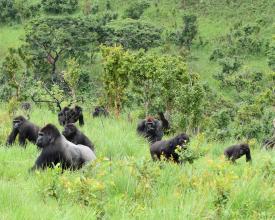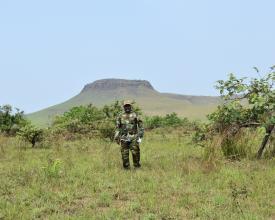
Applying a multi-faceted approach to achieve long-term sustainable conservation goals in a programme for the reintroduction of Critically Endangered western lowland gorillas to a protected area within the Republic of Congo

The Gorilla Protection Project began in 1987 with the aim of reintroducing Critically Endangered western lowland gorillas to an area they had been hunted to extinction. Young gorillas, orphaned by the illegal bush meat trade, receive care and rehabilitation at the project before release back to the wild. Also captive-bred gorillas are repatriated to Congo where, after a period of adjustment, they too are released into the reserve. The protection afforded to the area also allows a wider range of flora and fauna to benefit, improving the biodiversity and health of the eco-system. Yet the anthropogenic pressures remain. To achieve sustainable conservation results the project seeks to achieve a holistic solution by adopting a multi-faceted approach to a complex problem. This involves conservation initiatives that include local community development in the villages surrounding the reserve alongside enforcement and protection against unauthorised activities for the wildlife and habitat of the protected area.
Context
Challenges addressed
The release of rehabilitated or captive-bred animals back to the wild requires a multi-year commitment with an ability to adapt processes and procedures where necessary.
Civil wars and militia conflicts have plagued the Republic of Congo for many years, and even during periods of relative stability projects must be managed with a degree of sensitivity in this regard.
The people living in the villages surrounding the reserve are trapped in a subsistence lifestyle by poverty and the lack of opportunities in rural areas. This in turn leads to pressure on wildlife from practices such as poaching, fishing, and habitat loss/degradation. There is also an historical lack of economic and social empowerment, particularly affecting the younger generation and women. The resulting cycle of over-exploitation of natural resources can only be broken by tackling the complexities of the problem with multiple solutions requiring a cohesive and sustained programme of conservation and community development.
Location
Process
Summary of the process
The interaction of the building blocks follows a natural progression from early preparation and planning through to implementation and the future. Certain elements run throughout the building blocks, including collaboration, and good communication. Each block is not necessarily dependent on the others, but together they form a far more cohesive approach to addressing the complex situations that face most conservation projects. Following a logical pathway that brings together multiple aspects, particularly in areas involving human/wildlife conflict to any degree, provides a far better opportunity to achieve sustainable solutions.
Building Blocks
Collaboration of appropriate authorities and creating a team
Effective collaboration with the relevant authorities in the Republic of Congo is a key element to the project. This is not limited to permission to carry out conservation work in country, but is also important for the long-term relationships required, including the joint patrols of the reserve and enforcement of laws and regulations that are essential for long-term management of a protected or conservation area. Team composition is also extremely important and the Aspinall Congo team are almost entirely Congolese.
Enabling factors
A strong team formed of Congolese nationals who understand the systems and processes in country.
Lesson learned
Good communication, and development of mutual trust and respect are important to successful relationships.
Effective planning
The original aim of the project was the reintroduction of Critically Endangered western lowland gorillas back to a protected area in the wild. Initially the project would enable the release of rehabilitated wild-born orphans, with captive-bred animals repatriated from the UK as the project progressed. Having a clear aim enabled the plan to be developed and that included, but was not limited to:
- Location and establishment of the protected area
- Legal requirements, including licences and permissions
- Staffing requirements, including training
- Animal care, including veterinary support
- Identification of threats & pressures and mitigation measures required
- Infrastructure required
- Local community impact and engagement
- Local community support through capacity building and alternative income streams
- Funding requirements, including capital expenditure and operating costs
- Reporting Structure
- Sustainability
Projects are not static, they evolve and bring about change. In addition they can be affected by outside factors. Once the project commenced it has been subject to regular assessment. As the project developed it has broadened in scope and adaptations have been made through continuous oversight of the activities in progress.
Enabling factors
Highly motivated and skilled team members with access to training when required. Good communication, both in country and with team members in the UK head office. Clarity in the roles of the team and the decision-making process.
Lesson learned
Whilst the initial plan must be well-researched and well-constructed it must also be open to adaptation as necessary. There may be occasions when outside forces may impact on a project, for example during a period of civil unrest, where decisive prompt action will be required.
Local Community engagement
Involving local communities was a key element of our work in Congo from the beginning and, in 2010, The Aspinall Foundation was able to create a more formal structure with the establishment of PROFADELLL (The Project, in Favour of Local Development in Periphery of the Natural Reserve of Gorillas Lésio-Louna). Its aim to support communities on the outskirts of the enlarged Lésio-Louna Reserve with a comprehensive community programme to enable local people to benefit from, and become custodians of, their environment. The programme was in place for a period of ten years with positive results and elements such as the eco-tourism product are ongoing.
Enabling factors
Local rural communities depend on the natural resources around them and have a vested interest in making a transition to more sustainable lifestyles. Support of local and national authorities. A commitment from the team to build the trust necessary to gain support for the community programme.
Lesson learned
More successful results across the project are achieved if strong relationships with local communities are maintained. This requires a commitment to continually discuss and listen to points raised in regular meetings. Local community engagement is also crucial for positive conservation outcomes to be sustained.
Access to technology
Camera traps are an important tool for monitoring and gathering information, and have been used by the team for a number of years. More recently we have been able to train, and equip patrol teams in using the Spatial Monitoring and Reporting Tool (SMART).
Enabling factors
Patrol team members that are willing to learn and want to advance their skills, combined with an effective training programme for the use of different types of technology.
Lesson learned
Having access to the right technological tools increases efficiency of data collection and allows for more time efficient analysis. To take full advantage of the more advanced technology, such as SMART patrols which require a learning curve, effective training is required to ensure each patrol has a minimum of one fully-trained team member.
Project oversight, evaluation and future planning
Project oversight plays an important role in implementing lessons learned, and there is a constant flow of information between our team in Congo and the UK office. Beyond the core team access to other key professionals is also continuously available, such as our UK veterinary team, should their advice be needed. Setting effective baselines at the start of the project is an effective tool when evaluating progress. The project has no defined end date, and future planning is always under review. Information and data gained through oversight and evaluation are key elements of future planning.
Enabling factors
Good attention to detail and disciplined approach to record keeping. Good communication. The ability to be innovative and adapt to new, or changing, situations.
Lesson learned
Well trained and motivated staff ensure accurate data collection. Knowledge of local people is a valuable resource. It is important to build on successful elements of the project and equally important to analyse and adjust for the less successful so that future planning can benefit from both.
Impacts
The project's approach has led to a natural expansion of its scope. At its core there remains the initial focus of the reintroduction and protection of the western lowland gorilla population, but its impact has expanded beyond a single species. The health of the eco-system as a whole is integral to the project, and the complex inter-relationships between humans, wildlife and habitat are key elements. As with many of the remaining wilderness areas, the villages surrounding Lésio-Louna Reserve are some of the poorest in the country and they are highly dependent on the natural resources around them. Environmental and social resilience is achieved by empowering the local communities to transition from subsistence to sustainable lifestyles.
Since the inception of the project there is now a self-supporting population of wild gorillas in the reserve and other species, including hippos and forest buffalo, have increased in number. Through training, raising awareness, and building new income streams that encourage a desire to protect wildlife and habitats, local communities have gained new skills and a better understanding of the importance of sustainability. In addition to contributing to a number of SDGs this continued development will ultimately enable local people to become the custodians of their environment.
Beneficiaries
The main beneficiaries of the project are the local communities living in the 23 villages along the park boundaries (population in excess of 17,000) and, in a broader context, the government of the Republic of Congo.
Sustainable Development Goals
Story

In November 2020, thanks to the support we received from the European Union and the Organisation of African, Caribbean and Pacific States through the BIOPAMA Programme, we were able to significantly enhance our work in the Lésio-Louna Reserve. The aim was to improve the protection & management of the reserve through increased monitoring against illegal activities combined with the development of an existing eco-tourism product. It is an example of combining multiple approaches to achieve a single result, that being to protect the habitat and wildlife of the Lésio-Louna Reserve whilst remaining sensitive to the needs of local people. The purchase of a 4 x 4 vehicle and additional camera traps has allowed our team to organise regular patrols, and monitor activity, across a much wider area of the reserve than would be possible on foot. Combined with the use of SMART technology we are now gaining a better understanding of unauthorised activities that are occurring in the remote areas of the reserve and have been able to take action by destroying hunting camps, and confiscating items such as rafts/canoes, and hunting rifles. The presence of the patrols is also beginning to act as a deterrent through the awareness raising activities of our team. Alongside this strengthening of the rules and regulations we have also upgraded elements of an eco-tourism product through the installation of a new solar energy system and by increasing the capacity to offer river excursions. The creation of the eco-tourism product is an opportunity to involve local people through direct employment. As it becomes established and visitor numbers increase it also provides an income stream for residents of all 23 villages surrounding the reserve as a proportion of the revenue from eco-tourism is paid to the village associations for the benefit of the local people.












